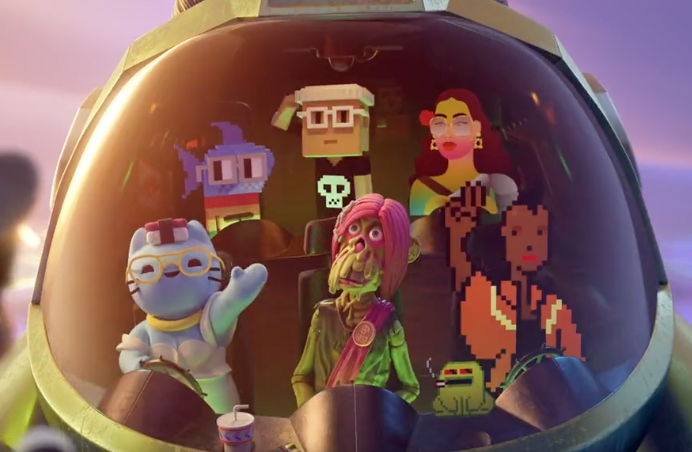simondlr #21 - Artistry In The Age of GPT-3
When I think of AI, one of the lasting imprints I have comes from the Spielberg/Kubrick film: A.I. Artificial Intelligence. Watching it when I was young, it was dark, disturbing, and depressing. This boy that just wants to be human, and to do what he was made for: to love. One of the persistent themes in it, is that: humans suck. Even the robot Teddy Bear in it is more redeeming than the humans throughout the film.

The themes of AI in stories has always been a useful mechanism to juxtapose our own humanity. In many cases, it’s dystopic, something we fear: authoritarian, aggressive, or indifferent. From “I, Robot”, Neuromancer, Ex Machina, Terminator, The Matrix, etc.
On the other hand, positive depictions come from being helpful, elucidating, and connecting. The Culture series, Interstellar, Her, Star Wars.
I do feel though that many of the positive depictions aren’t at the core of the story. In cases where AI is at the core of a story is more often, due to its negative traits: a villain, or antagonist.
(PS: I asked for examples on Twitter if you are interested in seeing what others proposed as positive examples. Some great examples that I missed!)
In reality, notable institutions like OpenAI was created, partly because of a fear of AI landing in the wrong hands. We tend to fear it, because it represents a potential unrestrained feedback loop. Waitbutwhy, puts it nicely in this graph.

I think it’s a reasonable concern. It presents an existential threat to oneself, and humanity.
I do also believe that AI can provide us with boundless opportunity for reinvention, artistry, and beauty if we choose to relinquish our ‘bio-narcissism’, as my friend, Trent McGonaghy puts it.
As it stands at the moment, GPT-3 has taken over discourse of AI with its ability to do a simple task, really well: predicting the next word.
It is with that, that I wrote down some thoughts on artistry in the age of GPT-3. What becomes of artistry, and humanity when AI can make beautiful things? How do we relate to it?
https://blog.simondlr.com/posts/artistry-in-the-age-of-gpt3
What are your thoughts?
—
Book Update! Hope Runners of Gridlock!
I was hoping to get a public beta of the novel out by now, but I’ve gone back to the writing desk to do 2 things: nailing the ending, and secondly, pruning point-of-view characters.
I’ve been going back and forth a lot on tweaking the ending in such a way that it respects the reader’s journey. I want to ensure, above all else, that it ends well. I feel I’m 95% there.
It’s been an interesting journey learning the art of storytelling, and it’s different nuances. The most persistent feedback of the closed BETA from readers was that the book felt almost too objective, and that the reader wanted to know more about how people felt, to peer inside the minds of the characters. I realised that my initial drafts were written indeed, very objectively, almost like a film script. And so, I went back and indulged a bit more, detailing how characters were feeling. Unfortunately, in reading it, I discovered the pendulum had swung too much to the other side: too many point-of-views (up to 8 in a 300-page novel). It’s just too much and it jumps around too often. So, I’ve cut down on perspectives, to only the three main characters. It means I have to go back and prune the book in some parts, and expand in others.
I also did a personal exercise of writing similar to the ‘ducky method’ in programming: to explain yourself to an imaginary duck. In other words, I go through each chapter and explain to a fictional ‘reader’ why I made specific choices, and why it’s important. In explaining it, it helps elucidate the good parts, and the bad parts. If I can’t explain why it’s important, I cut it. As the famous editing dictum goes: “Kill your darlings”.
Stephen King had this to say on the art of writing in his book On Writing: A Memoir of the Craft: “Kill your darlings, kill your darlings, even when it breaks your egocentric little scribbler’s heart, kill your darlings.”
I’ve definitely been enjoying this process and hope to share the public BETA of the novel with you all soon.
Links!
Transparent Pixels As *Art*
I love conceptual art, and this example of Pak, selling a transparent pixel for $15k is *great*. Pak, for those that don’t know, is behind the famous Archillect bot. I do understand that it *angers* and frustrates more traditional artists, but I love conceptual art its purpose in creating a unique feeling. That confusion, anger, that jarred liminality is part of its purpose. I enjoy it.
ETH 2.0 Phase 0 Coming!
I’m super excited to see that the hopefully final, ETH 2.0 phase 0 testnet will be going live in August. It’s been a long time coming. Looking forward to running a node and playing again. It feels like the early days of Ethereum. A new toy to play with!
Tea
I developed a tea-drinking habit. As I’m writing this, I’m drinking a mixture of Rooibos, Honey Bush, and Buchu. Very South African mixture of herbal tea. I asked on Twitter for tea recommendations. If you like tea, this is a great resource. Let me know what teas you enjoy!
RadicalXChange
One of the reasons I enjoy the RadicalXChange movement is its purpose of pushing for diversity of thought and ideas: from political economy, to markets, to social justice movements, to art, to absurdism. This blog post breaks some of these themes.
Infinite Machine
This book by Camilla Russo covers the early days of Ethereum. Entirely biased, but I enjoyed it. It brought back good memories. So much still is going to happen. It’s only been 5 years since it was launched. If you are not into Ethereum, it’s also a really good account on how sometimes things happen due to luck: just being at the right place, at the right time. A lot of hard work went into Ethereum, but this narrative also shows that a lot could’ve gone wrong.
That’s all folks. Hope you get to enjoy a sunset!
Cheers
Simon

